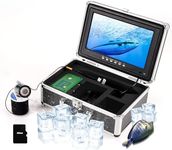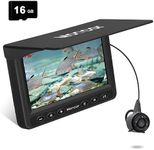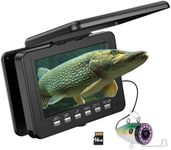Buying Guide for the Best Underwater Fishing Cameras
Choosing an underwater fishing camera can make your fishing trips more exciting and productive by letting you see what’s happening below the surface. To find the best camera for your needs, it’s important to understand the main features and how they relate to your fishing style, the environments you fish in, and the level of detail you want to see. By focusing on the key specifications, you can make sure you pick a camera that matches your expectations and helps you get the most out of your time on the water.Camera ResolutionCamera resolution refers to the clarity and detail of the images or videos the camera captures. Higher resolution means sharper and more detailed visuals, which can help you identify fish species and underwater structures more easily. Resolutions typically range from standard definition (SD) to high definition (HD) and even full HD or 4K. If you want to see fine details or plan to use the footage for sharing or analysis, go for higher resolutions. For casual viewing or basic fish spotting, lower resolutions may be sufficient and can save on storage space.
Depth RatingDepth rating tells you how deep the camera can go underwater without being damaged. Cameras are usually rated for shallow, medium, or deep water use. If you fish in lakes, rivers, or shallow coastal areas, a lower depth rating may be enough. For deep-sea fishing or exploring deeper waters, look for a camera with a higher depth rating to ensure it can handle the pressure and stay functional.
Field of View (FOV)Field of view describes how wide an area the camera can capture at once. A wider field of view lets you see more of the underwater environment, which is helpful for spotting fish and observing their behavior. Narrower fields of view focus more on specific spots, which can be useful for detailed inspection. Choose a wider FOV if you want a broad overview, or a narrower one if you’re interested in close-up details.
Lighting/Infrared CapabilityLighting or infrared capability refers to the camera’s ability to see in low-light or murky water conditions. Some cameras have built-in LED lights or infrared sensors to help illuminate the area and improve visibility. If you often fish in dark, deep, or cloudy waters, look for a camera with strong lighting features. For clear, shallow water, basic lighting may be enough.
Display Type and SizeThe display is the screen where you view the camera’s live feed. Displays come in different sizes and types, from small, portable screens to larger, high-resolution monitors. A bigger, clearer display makes it easier to see details, but may be less portable. If you want something easy to carry, a smaller screen might be better. Think about where and how you’ll use the camera to decide what display size and type fits your needs.
Battery LifeBattery life determines how long the camera can operate before needing a recharge. Longer battery life is important for extended fishing trips or if you plan to use the camera for many hours at a time. If you only fish for short periods, a shorter battery life may be fine. Consider your typical fishing session length and pick a camera that can last as long as you need.
Cable LengthCable length is the length of the cord connecting the camera to the display or control unit. Longer cables let you lower the camera deeper or farther from your boat or dock. If you fish in deep or large bodies of water, a longer cable is useful. For shallow or small areas, a shorter cable is easier to manage and less likely to tangle.
Durability and WaterproofingDurability and waterproofing refer to how well the camera can withstand rough handling, water exposure, and harsh conditions. Look for cameras with strong, sealed housings and good waterproof ratings if you fish in challenging environments or want a camera that will last. If you fish in calm, controlled settings, basic durability may be enough.

![FishPRO [2024 Upgrade] Underwater F](https://images-proxy.bestreviews.guide/Y_XplSE5sy-gu8ZUtXJSeqdPtjo=/0x150/https://m.media-amazon.com/images/I/4156GyGV9TL._AC_CX679_.jpg)
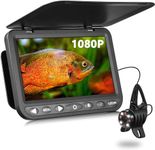

![FishPRO [2024] Underwater Fishing C](https://images-proxy.bestreviews.guide/Pr6Dd9yww1qkUiqV0O3b72ueQXw=/0x150/https://m.media-amazon.com/images/I/41FizQ5NLLL._AC_CX679_.jpg)

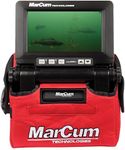


![FishPRO [2024 Upgrade ] 7'' Underwa](https://images-proxy.bestreviews.guide/usEW1WDNkwgHpd_cX1myqKPTBbA=/0x150/https://m.media-amazon.com/images/I/41UQYz4B7yL._AC_CX679_.jpg)
